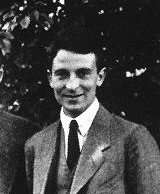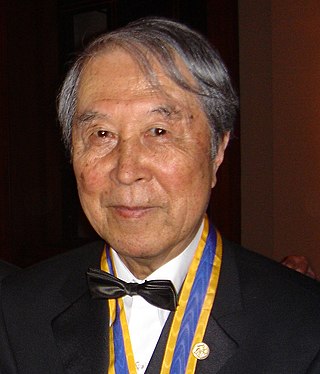
In particle physics, a fermion is a subatomic particle that follows Fermi–Dirac statistics. Fermions have a half-odd-integer spin and obey the Pauli exclusion principle. These particles include all quarks and leptons and all composite particles made of an odd number of these, such as all baryons and many atoms and nuclei. Fermions differ from bosons, which obey Bose–Einstein statistics.

Lev Davidovich Landau was a Soviet physicist who made fundamental contributions to many areas of theoretical physics. He was considered as one of the last scientists who were universally well-versed and made seminal contributions to all branches of physics. He is credited with laying the foundations of twentieth century condensed matter physics, and is also considered arguably the greatest Soviet theoretical physicist of the twentieth century.

Frank Anthony Wilczek is an American theoretical physicist, mathematician and Nobel laureate. He is the Herman Feshbach Professor of Physics at the Massachusetts Institute of Technology (MIT), Founding Director of T. D. Lee Institute and Chief Scientist at the Wilczek Quantum Center, Shanghai Jiao Tong University (SJTU), distinguished professor at Arizona State University (ASU) and full professor at Stockholm University.

Oskar Benjamin Klein was a Swedish theoretical physicist.

Brian David Josephson is a British theoretical physicist and professor emeritus of physics at the University of Cambridge. Best known for his pioneering work on superconductivity and quantum tunnelling, he was awarded the Nobel Prize in Physics in 1973 for his prediction of the Josephson effect, made in 1962 when he was a 22-year-old PhD student at Cambridge University. Josephson is the first Welshman to have won a Nobel Prize in Physics. He shared the prize with physicists Leo Esaki and Ivar Giaever, who jointly received half the award for their own work on quantum tunnelling.

Ennackal Chandy George Sudarshan was an Indian American theoretical physicist and a professor at the University of Texas. Prof.Sudarshan has been credited with numerous contributions to the field of theoretical physics, including Glauber–Sudarshan P representation, V-A theory, tachyons, quantum Zeno effect, open quantum system and quantum master equations, spin–statistics theorem, non-invariance groups, positive maps of density matrices, and quantum computation.

Yoichiro Nambu was a Japanese-American physicist and professor at the University of Chicago.
Kerson Huang was a Chinese-born American theoretical physicist and translator.

Anthony Zee is a Chinese-American physicist, writer, and a professor at the Kavli Institute for Theoretical Physics and the physics department of the University of California, Santa Barbara.
Victor Gershevich (Grigorievich) Kac is a Soviet and American mathematician at MIT, known for his work in representation theory. He co-discovered Kac–Moody algebras, and used the Weyl–Kac character formula for them to reprove the Macdonald identities. He classified the finite-dimensional simple Lie superalgebras, and found the Kac determinant formula for the Virasoro algebra. He is also known for the Kac–Weisfeiler conjectures with Boris Weisfeiler.
B. Adolf Kratzer was a German theoretical physicist who made contributions to atomic physics and molecular physics, and was an authority on molecular band spectroscopy. He was born in Günzburg and died in Münster.

Xiao-Gang Wen is a Chinese-American physicist. He is a Cecil and Ida Green Professor of Physics at the Massachusetts Institute of Technology and Distinguished Visiting Research Chair at the Perimeter Institute for Theoretical Physics. His expertise is in condensed matter theory in strongly correlated electronic systems. In Oct. 2016, he was awarded the Oliver E. Buckley Condensed Matter Prize.
Combinatorial physics or physical combinatorics is the area of interaction between physics and combinatorics.
Gennadi Sardanashvily was a theoretical physicist, a principal research scientist of Moscow State University.
Gerhart Lüders was a German theoretical physicist who worked mainly in quantum field theory and was well known for the discovery and a general proof of the CPT theorem. This theorem is also called the Pauli-Lüders theorem and is one of the most fundamental rules of particle physics.

Stefan Janos is a Slovak-Swiss university physicist and professor, founder of very low temperature physics in Slovakia.

Kameshwar C. Wali was an Indian-born American theoretical physicist who was the Distinguished Research Professor of Physics Emeritus at Syracuse University's College of Arts and Sciences. He was a specialist in high energy physics, particularly symmetries and dynamics of elementary particles, and the author of Chandra: A Biography of S. Chandrasekhar and Cremona Violins: a physicist's quest for the secrets of Stradivari.
Peter Fulde was a German physicist working in condensed matter theory and quantum chemistry.
Narendra Kumar was an Indian theoretical physicist and a Homi Bhaba Distinguished Professor of the Department of Atomic Energy at Raman Research Institute. He was also an honorary professor at Jawaharlal Nehru Centre for Advanced Scientific Research.
Rudolph C. Hwa is an American theoretical physicist and Professor emeritus at the University of Oregon. His areas of interest include the strong interaction, nonlinear dynamics, fluctuations, and quark–gluon plasma. He was elected an American Physical Society Fellow in 1995.











